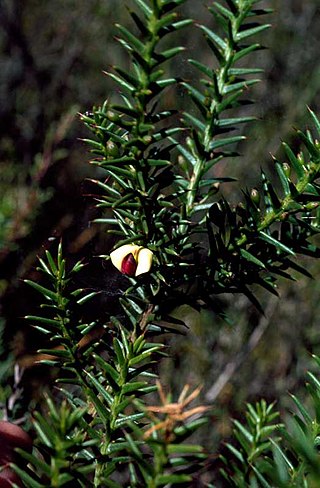
Fagonia is a genus of wild, flowering plants in the caltrop family, Zygophyllaceae, having about 34 species. The latest reorganization of the genus took place in 2018 when systematists Christenhusz & Byng, Royal Botanical Gardens, Kew (UK) included Fagonia spp.. along with several other Zygophyllum genera, into a new genus named "Zygophyllum L." Species occurring in the US are commonly referred to as fagonbushes. The distribution of the genus includes parts of Africa, the Mediterranean Basin, the Mid-East, India, and parts of North & South America. Fagonia species have been used ethnobotanically by traditional practitioners under Ayurvedic and other TM healing regimes for many maladies. Species occur in deserts, dry washes, ditches and on rocky outcrops, including at altitude.
Monolistra is a genus of isopod crustaceans in the family Sphaeromatidae. Its members are restricted to countries of the former Yugoslavia, Italy and Switzerland. It contains the following subgenera and species, four of which are listed as vulnerable (VU) or endangered (EN) on the IUCN Red List:
Monolistra spinosissima is a species of isopod in the family Sphaeromatidae.

The Pacific white skate is a species of skate in the family Arhynchobatidae. It is one of the deepest-living of all skates, occurring at a depth of 800 to 2,906m on the continental slope. It is native to the southeast Pacific Ocean from the Galapagos Islands to off Waldport, Oregon; an egg case and embryo has been collected from the Farallon Islands off San Francisco. In 2023, the largest nursery of the species was discovered in the Pacific coast of Canada.

Mammillaria spinosissima, also known as the spiny pincushion cactus, is a species of flowering plant in the cactus family Cactaceae, endemic to the central Mexican states of Guerrero and Morelos, where they grow at elevations of approximately 1,600 to 1,900 metres. The species was described in 1838 by James Forbes, gardener of the Duke of Bedford. Botanist David Hunt collected a specimen in 1971, when he located one near Sierra de Tepoztlan, Mexico.

Amparoina spinosissima is a species of fungus in the family Tricholomataceae, and the type species of the genus Amparoina. It was originally named Mycena spinosissima by mycologist Rolf Singer in 1951, who had originally found the species in Argentina in 1949. He transferred it to Amparoina in 1958.

Allocasuarina spinosissima is a species of flowering plant in the family Casuarinaceae and is endemic to Western Australia. It is a monoecious shrub with its leaves reduced to overlapping scales in whorls of nine to eleven, the mature fruiting cones 10–23 mm (0.39–0.91 in) long, containing winged seeds 5.5–7.0 mm (0.22–0.28 in) long.

Grevillea spinosissima is species of flowering plant in the family Proteaceae and is endemic to the southwest of Western Australia. It is a spiny shrub with three-part leaves with sharply-pointed, linear lobes, and clusters of creamy-white and green to mauve flowers with a white style.

Eutrichota is a genus of flies within the family Anthomyiidae.
Eutrichota lividiventris is a species of root-maggot flies in the family Anthomyiidae.
Eutrichota geomyis is a species of root-maggot flies in the family Anthomyiidae.
Eutrichota gopheri, the gopher tortoise burrow fly, is a species of root-maggot flies in the family Anthomyiidae.
Eutrichota affinis is a species of root-maggot flies in the family Anthomyiidae.

Chirosia is a genus of root-maggot flies in the family Anthomyiidae. There are over fifty described species in Chirosia.
Eutrichota cylindrica is a species of root-maggot flies in the family Anthomyiidae.

Eutrichota lipsia is a species of root-maggot flies in the family Anthomyiidae.
Prunus spinosissima, the thorny almond, is a species of wild almond native to dry areas of Central Asia, Afghanistan, and Iran, preferring to grow at 400-1500 m above sea level. It is morphologically similar to Prunus erioclada, P. lycioides, P. eburnea and P. brahuica.
Prunus turcomanica, the Turkmen almond, is a putative species of wild almond native to Iran, Turkmenistan and possibly eastern Turkey. A genetic and morphological study has shown that it is conspecific with Prunus spinosissima.

Hovea asperifolia is a species of flowering plant in the family Fabaceae and is endemic to south-eastern continental Australia. It is a shrub with hairy branchlets, narrowly oblong to narrowly linear leaves with stipules at the base, and mauve, pea-like flowers.

Daviesia spinosissima is a species of flowering plant in the family Fabaceae and is endemic to the south of Western Australia. It is a shrub with crowded, rigid, sharply-pointed, narrowly triangular phyllodes, and yellow and red flowers.










